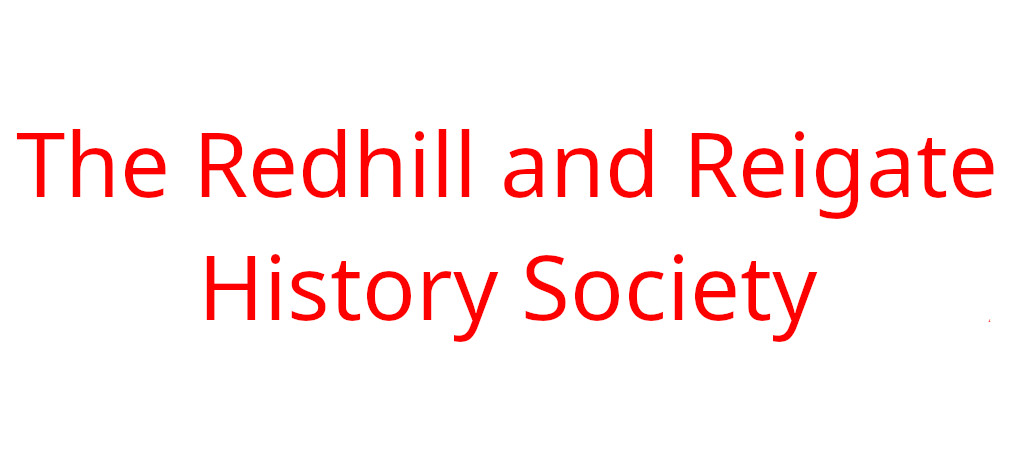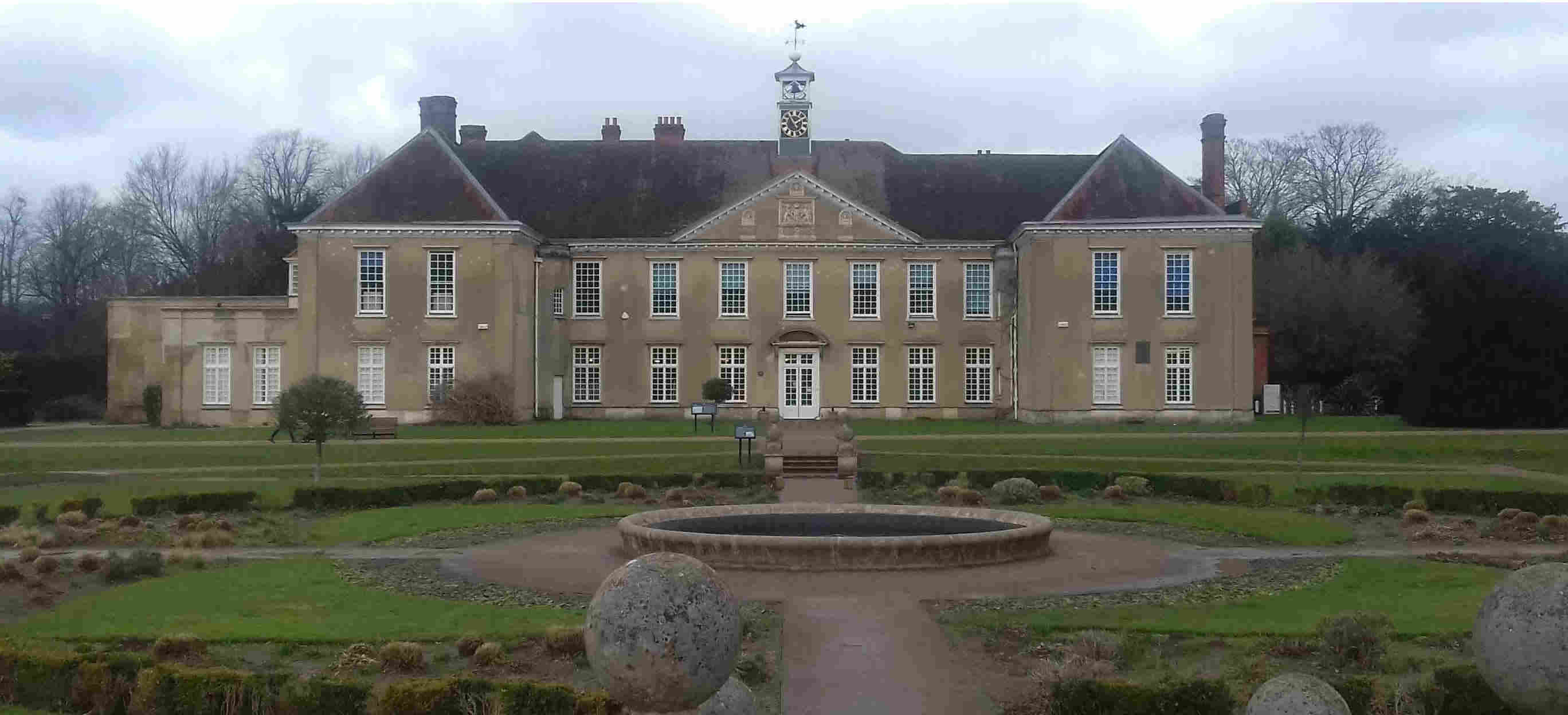The History of the Bell Street Post Office
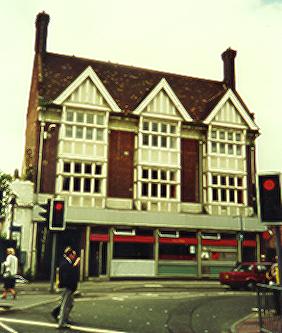 |
Reigate Bell street Post Office, partly visible two pictures above, was demolished in January 1993. A brief history of the Reigate Post Office is given right.(Picture John Ede) | | |
| |
The building shown on the left was erected in 1895 and
prior to this the PO was situated in the High Street in
much smaller premises. The then postmaster, Mr Bull,
wrote to the Council suggesting money be borrowed under
the Post Office Act of 1874 to provide a better building.
Mayor Samuel Brooks, Mr J.Seex (an ex-Mayor) Mr H.Ongley
and Mr J.Lees went to see Sir James Ferguson, the
Post-Master General, only to be told that no money was
available. So Reigate traders T.S.Marriage, H.Ongley, J
and G.Hammond, J.Keasley, and R.Elphick, supplied the
money and work begun. A building for many years used as a
school by the then late Mr J.Payne was pulled down and
the foundation stone of the new Bell Street PO laid by
the daughter of Mr T.S.Marriage on October 22nd 1894. The
opening ceremony was performed by Lady Henry Somerset on
June 25th 1895. Above the PO office was the old Reigate
manual telephone exchange that was there until a new
automatic exchange opened in Church Street in 1937. The
PO did not reach its centenary on this site as the
building was demolished in 1993, its counter services
being moved to Safeways (now Morrisons). It was announced
on 17th February 2005 in local papers that it is to be
relocated in a shop called 'More' in the High Street.
|
|
|
|
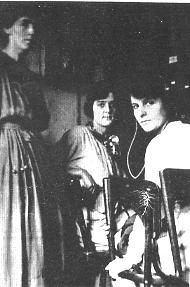 |
|
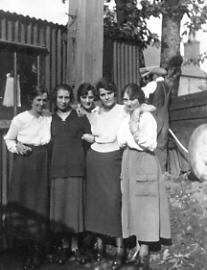 |
|
These two pictures date from the 1920s
and show operators at the telephone exchange switchboard
and in what is presumably a part of the exterior area at
the rear of the Post Office building. In the right hand
picture the girls are standing in front of what was
probably the main distribution pole for the exchange in
the days when most of the local 'phone lines were served
by open wires run overhead. On the right, however, a
linesman seems to be running a cable from a wooden drum.
Who was manning the switchboard when this picture was
being taken is uncertain as five operators was the full
compliment for the exchange. In many of the adverts on
these pages telephone numbers are three of fewer digits,
although later the numbers exceeded 1000. All numbers
were standardised at four digits beginning with 2 when
the present exchange was built in Church Street in 1937.
|
| |
|
|
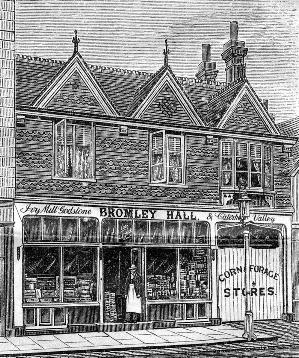 |
|
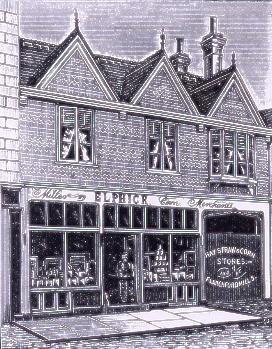 |
|
These two drawings show the same
double-fronted premises which on the left is known as
Bromley Hall, which according to the sign over the front
window is a firm of millers and corn merchants, and on
the right belongs to Mr Elphick, a miller and corn
merchant. Little is known about Bromley Hall but Mr
Elphick carried on his business at Reigate and Flanchford
Mill and featured in an 1891 business guide published
locally. The building was on the east side of Bell Street
next to what became cinema. There is a puzzle here
because reference to both drawings show access to the
rear of the premises next to the shop whereas reference
to the photo below shows that there was another building
between Bromley Hall and the double-doored entrance for
horsedrawn vehicles
. (left-hand drawing above courtesy
HNHM)
|
| |
|
|
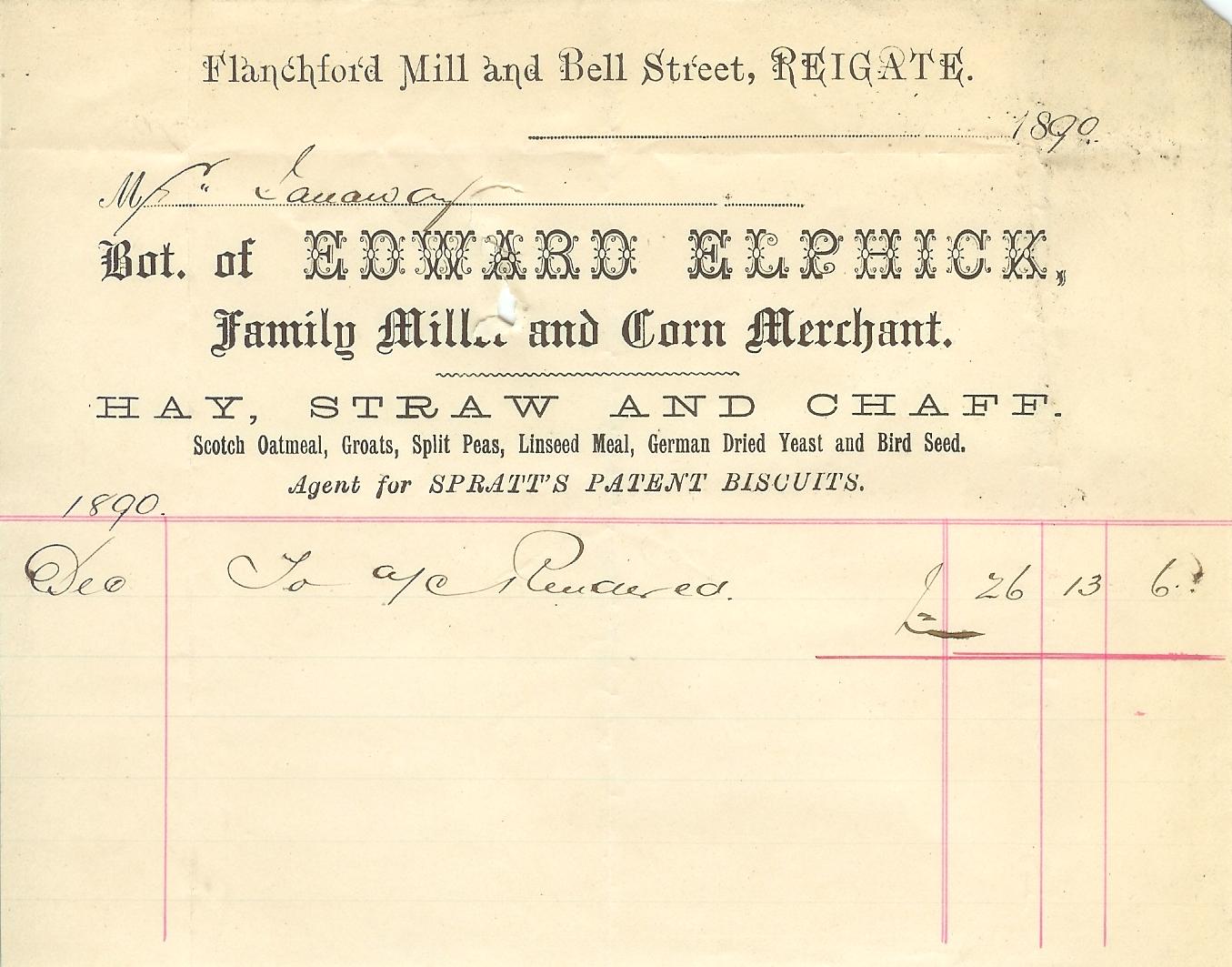 |
|
This invoice in the sum of from Edward
Elphick to Mr Lanaway of Reigate dates from 1890. It
states 'To a/c rendered' and is probably prompting
payment of a total of £26-13-6 before the year end.
Apart from hay, straw and chaff scotch oatmeal, groats,
split peas, linseed meal, German dried yeast and bird
seed are also sold. In 1890 Flanchford Mill would have
been a busy working watermill. When I paid a visit there
a few years ago the water wheel had obviously been
derelict for quite a few decades
(Invoice courtesy L.Robertson)
|
| |
|
|
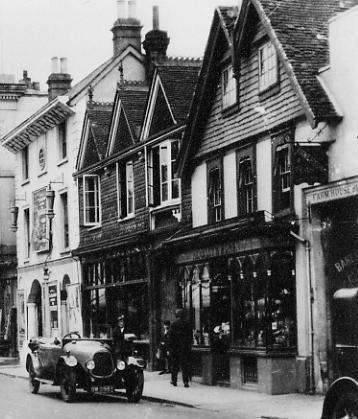 |
|
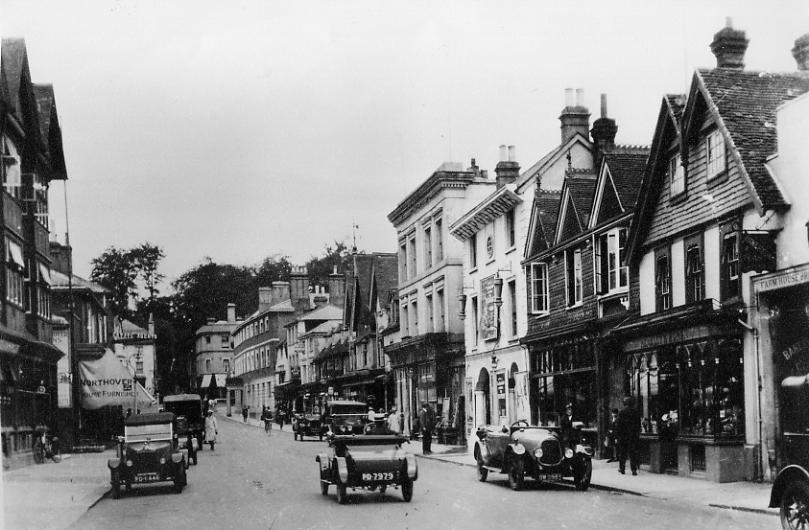 |
|
The building featured in the previous
drawings can be recognised easily in this early 1930s
picture (detail left - overall picture right) by its
distinctive set of three gables. Here it is occupied by
R.Saunders. Close inspection, however, shows that the
nearer building, the one with two gables, is actually the
one with the wagon entrance next to it. Both of these
were demolished when Bancroft Road was built. The
Hippodrome Cinema is the white building. We must assume
that the building and its access were shown together for
advertising purposes. Incidentally, in the right-hand
picture the car on the left is a Standard, the one on the
right an Angus Sanderson
|
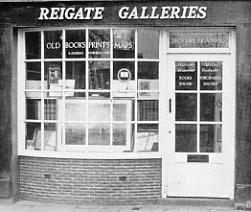 |
Antiquarian booksellers Reigate
Galleries at 45 Bell Street in 1970 |
| |
| |
The shop with the two gables,
number 31 Bell Street and the building that actually had
the wagon entrance adjacent to it, was occupied for many
years by Keasley & Sons, a sweet, jam and cake
business started by the father of James Keasley around
1819. One of the oldest buildings in the town it was once
the Ship Inn. In 1916 the business was bought by Mr
G.A.R.Ince, a man who had been Reigate's Mayor 1913-1916.
At the time of purchase it was repoerted in the press
that one and a half tons of jam and 5,000 cakes were
being sold each week. In November 1913 Mr Ince was fined
£2 on two counts of selling jam overprice by charging a
refundable 6d for large jars. During the case he objected
to the then current Mayor adjudicating on the grounds od
predjudice. The objection was refused but it seems
remarkable that the Mayor for 1913-1916 should be judging
his immediate predescessor. Mr James Keasley died at
'Hawthorns' Meadvale, in 1924.
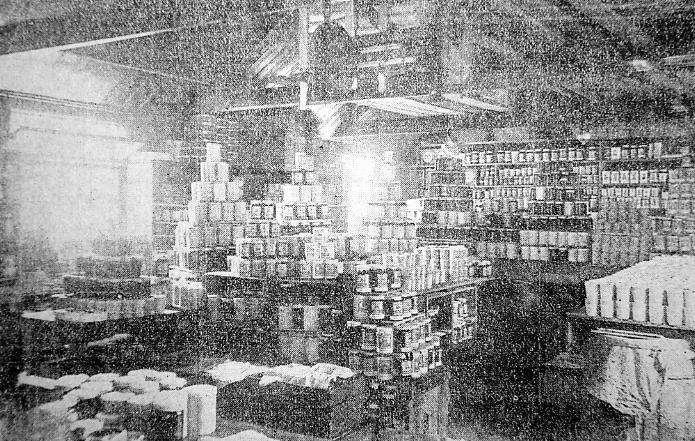 |
|
A poor picture, unfortunately, but it
shows jars of jam and other items stacked high in
Keasley's shop in 1919
| |
|
| |
|
|
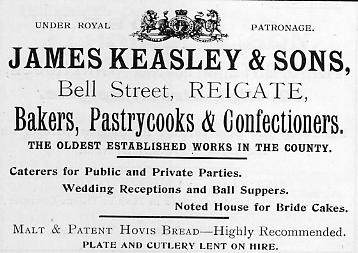 |
|
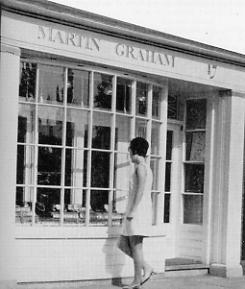 |
|
A James Keasley advert from
1905
|
|
Martin Graham's shop at 47 Bell
Street in 1968
|
| |
|
|
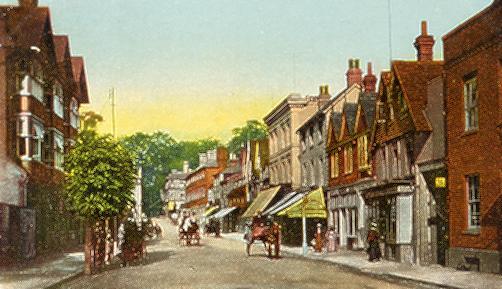 |
|
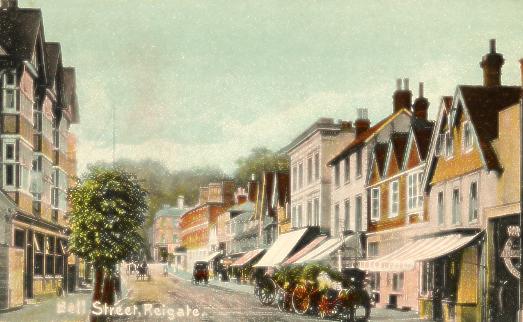 |
|
Two more inmages of Bell Street, both
earlier than preceding pictures. Like those previous
images, they show the sloping roof of the Hippodrome
cinema and the buildings to the south of it that were
demolished to make way for the new Bancroft Road
|
| |
|
|
|
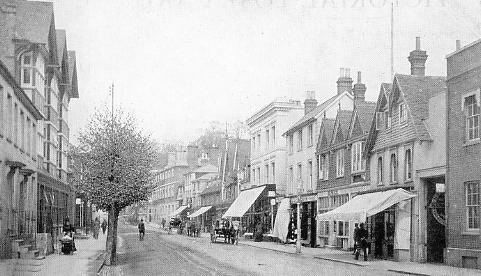
A nice
wide-angle image of the upper part of Bell Street c1900.
It shows buildings on the left that must have been
demolished to make way for the Rt Garage showrooms in the
picture below, the Post Office, and on the opposite side
of the road many of the other buildings discussed on this
page
|
| |
|
|
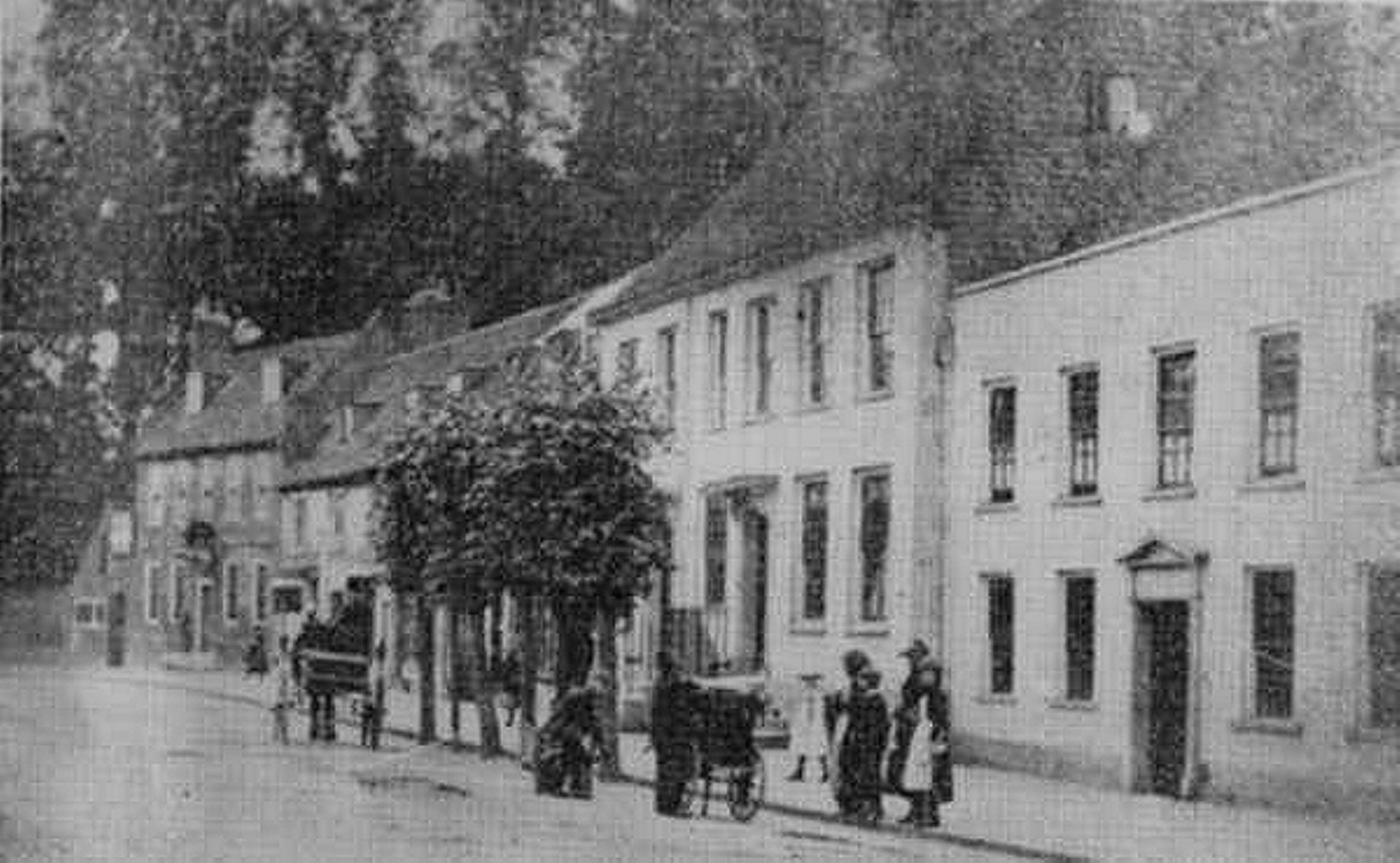
This
picture views the site of the 1895 Post Office from the
position of the horse and cart in the above picture and
shows the buildings that existed before the Post Office
and the Reigate Garage buildings were erected. Comparison
with the trees in this picture and the one above shows
relative old and new building postions
Picture
very kindly donated to this web page by Paul Walters from
his own collection
|
| |
|
|
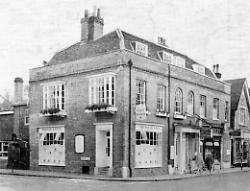 |
|
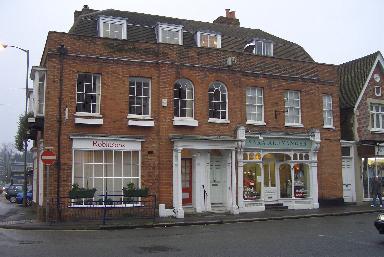 |
|
On the south-east corner of
Bell Street and Bancroft Road is 'The Old Georgian
House', built in the 1930s in the Georgian style to
replace the demolished buildings in previous pictures. It
is pictured on the left in 1969, when the ground floor
offices were occupied by estate agents Skinner and Rose,
and on the right in 2005
|
| |
|
|
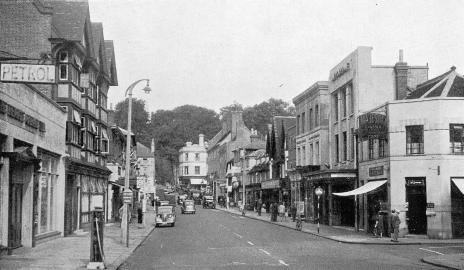 |
|
PALACEPICTUREDROMEREIGATE - 'Phone
421
ProprietorAlfred Wright - - - Manager L. Oswald
Hillier
CONTINUOUS CINEMATOGRAPH ENTERTAINMENT
Daily 6 to 10.30pm Wednesday and Saturday 3 to
10.30pm
CONSTANT CHANGE OF PROGRAMME - THE PICK OF THE PICTURES
Dramas, Comedies, Scenics, Historical and Coloured Films
- all of the very latest.
DELIGHTFUL MUSIC - SPECIAL STAR PROGRAMME
throughout the week commencing MONDAY JULY 8TH, 1912,
including the following Magnificent Feature Films:
THE BEAUTIFUL PRINCESS AND THE MERCHANT - Grand Coloured
Drama (by Pathe); a most elaborate and stirring
production of oriental character.
MR BOULTER'S INFATUATION - Side splitting Vitograph
comedy.
THE DIAMOND BROOCH - A cleverly enacted drama dealing
with stage lifeTHE LESSER EVIL -
Powerful nautical drama, with Miss Daphne Wayne in the
leading role, the abduction of a pretty girl by smugglers
and subsequent rescue by her lover. One of the latest and
most successful pictures.
Also various other Interesting and Entertaining Subjects.
Admission …… 3s 6d and 1s (Balcony)
Balcony seats (high-class tip-ups) may be booked at no
extra charge
|
| |
|
|
|
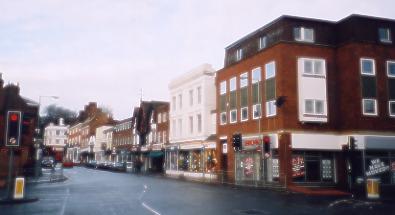
The
above b&w picture from the late 30s/early 40s shows
not just that Bancroft Road was made and formed a new
junction with Bell Street but also that the Hippodrome
Cinema was either rebuilt or remodelled and a shop with a
flat over added alongside it. The flat was at one time
occupied by the proprietor of the Hippodrome and Majestic
Cinema's sister, who was the landlord of Jimmy Bridger
when he ran the shop as a newsagents and confectioners.
The Hippodrome was originally named The Palace
Picturedrome and was Reigate's first cinema in 1911.
Above right is an advert for films showing in 1912. It
was built by wealthy, retired company director Mr Alfred
Wright and had its first public performance on December
18th 1911. Prices ranged from 3d to 1s 6d and 5,000
people attended in the first week. Its name was changed
to The Hippodrome either in 1915, or the following year
when it was acquired by Mr H.Bancroft. In the 1920s it
was often advertised as the New Hippodrome, probably
because of being rebuilt around that time. It held 700
people. In the 1950s Mr Bancroft, still its owner, was
often to be seen there in evening dress with his wife
greeting patrons as they arrived. Mr Wright, its first
owner, died in London in 1949 aged 77. The colour picture
here shows almost exactly the same scene as above it. Not
only has Bancroft Road been made and the corner shop and
the Hippodrome been replaced but with the demolition of
the Post Office and the Reigate Garage a new road has
been made into the old Brewery site and a supermarket and
car park built there. (The brewery is dealt with below)
|
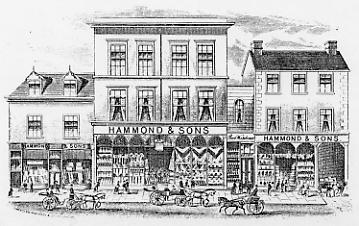 |
|
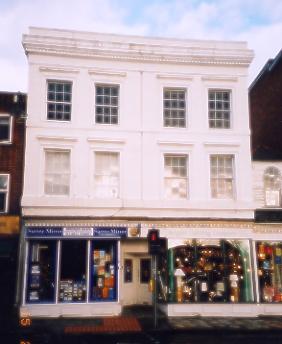
|
|
An 1891 advertisement for
Hammond & Sons, who were drapers, tailors, outfitters
and general furnishers. The building on the right, also
part of Hammond & Sons, later became the Hippodrome
Cinema. By 1903 the firm was known as Hammond and Dawson
|
|
The building once occupied by
Hammond & Sons as pictured in 2004. The single shop
is now two separate businesses in the main building with
additional businesses either side
|
| |
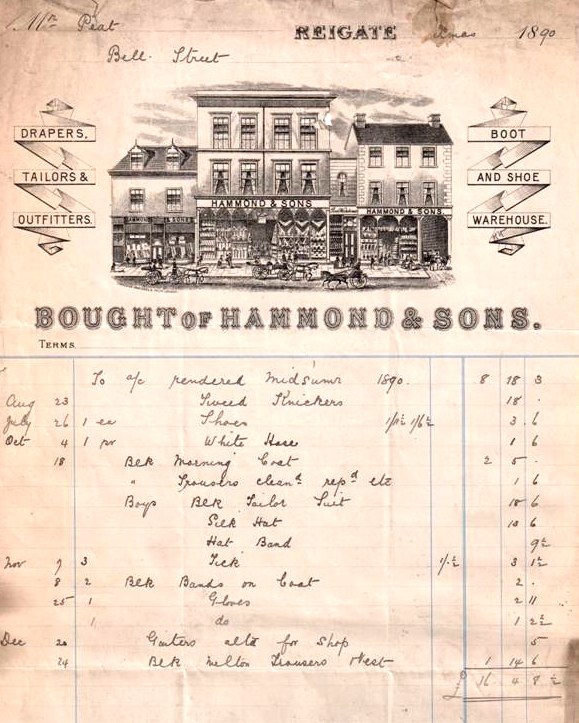 |
|
A wonderful Hammond and & Sons bill from
1890 kindly sent in by Mr L Robertson. The bill is made
out to Mr Peat, also of Bell Street, and is dated xmas
1890. Items listed are: -
| To a/c rendered midsummer
1890 |
8 |
18 |
3 |
|
Tweed
Knickers
|
|
18
|
|
|
Shoes
|
|
3
|
6
|
|
White
Hose
|
|
1
|
6
|
|
Black
Morning Coat
|
2
|
5
|
|
|
Black
trousers cleaned and repaired
|
|
1
|
6
|
|
Boys
black tailor suit
|
|
18
|
6
|
|
Silk
hat
|
|
10
|
6
|
|
Hat
band
| |
|
9½
|
|
Tick
1/ ½
|
|
3
|
1½
|
|
Black
bands on coat
|
|
2
| |
|
Gloves
|
|
2
|
11
|
|
ditto
|
|
1
|
2½
|
|
Gaiters
alta for shop
|
|
|
5
|
|
Black
Melton trousers
|
1
|
14
|
6
|
| |
|
|
|
|
£
|
16
|
4
|
8½
|
|
| |
|
|
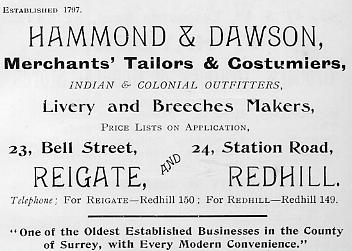 |
|
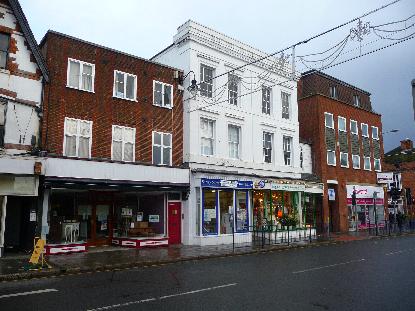 |
|
1903 advert for Hammond and
Dawson
|
|
The buildings either sdie of
the central shop premises have gone and the remaing shop
has been divided into two
|
| |
|
|
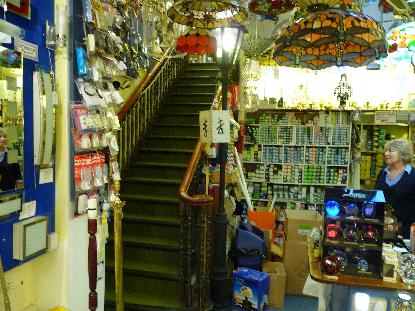 |
|
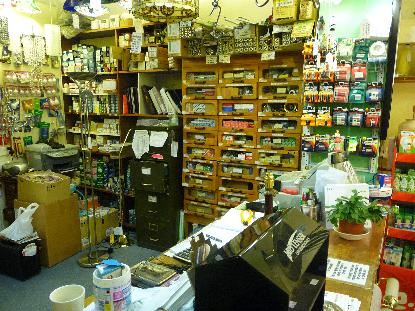 |
|
The right hand half of what
remains of Hammonds' old premises is a lighting shop and
contains the original central staircase
|
|
Some of the shelves and shirt
drawers are still in situ from the last time the premises
was a gents outfitters
|
| |
|
|
The Majestic Cinema
|
|
The Majestic Cinema was
built in the newly made Bancroft Road in 1934 and opened
in 1935. On a grander scale than previous cinemas it had
a large, free car park, room for an upstairs public cafe,
a lounge area and an electric organ that rose from
beneath the stage to be played before each performance.
The organ lay dormant for a number of the cinema's latter
years and was finally sold in 1973 to an organ enthusiast
in Norfolk. Its tones were heard again when it was
featured in a BBC radio programme in 1998. The Majestic
Cinema formed part of the Shipman and King Empire. Access
to it was created from Church Street at one end and Bell
Street at the other by the building of Bancroft Road. In
the way of the new development, which also included a
swimming pool, was Baron's Cottage, said to have been
over 500 years old and in its early days the
priest’s house attached to the catholic monastery
which extended to Bell Street, with caves running to its
cellars from the White Hart Hotel. It should be stressed
that other than the report in the local paper of the time
on which the above is based, evidence for the existence
of such a monastery seems lacking (other than the choice
of the name for Monks Walk). As far as the Barons Cottage
is concerned, when speaking about the building of the
Majestic cinema in 1933 Mr Bancroft, manager of the
Reigate Hippodrome and instigator of the new development,
answered local concerns by saying that if it could be
saved then it would be. It would seem that it could not,
so is lost to us for ever and I have, unfortunately, no
picture of it.
|
| |
|
|
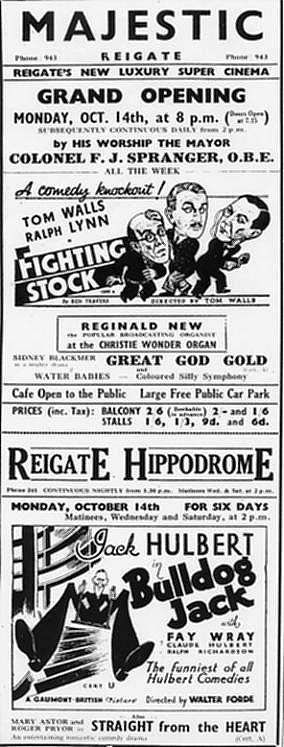 |
|
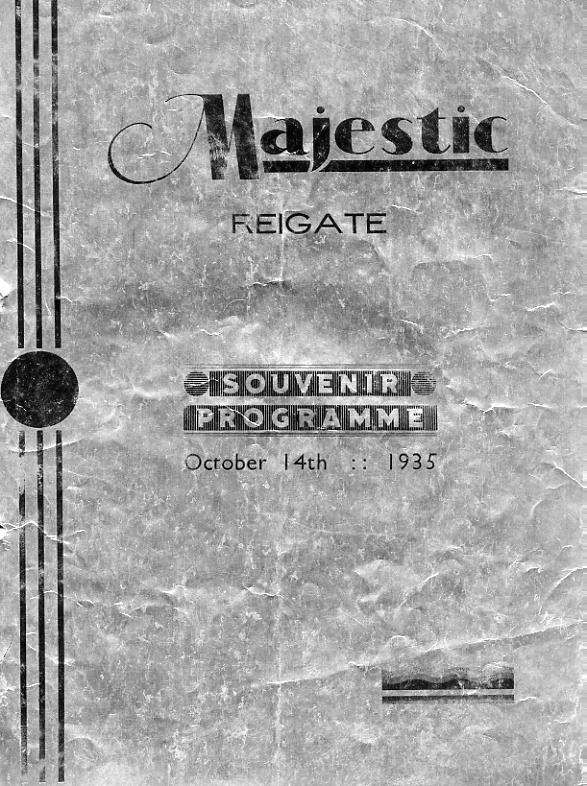
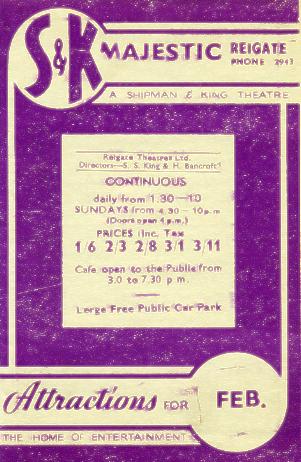
|
|
Left:
- The 1935 advertisement for the opening week of films
for 'Reigate's New Luxury Theatre'.
Top right: - The
souvenir programme for the opening of the Majestic Cinema
on October 14th 1935
Bottom right: - Cards
like this cost 1d from the kiosk inside the theatre and
opened to show coming attractions for the month. This one
is from February 1953 when films included Esther Williams
in The One-Piece Bathing Suit, Burt Lancaster in The
Crimson Pirate, and Stewart Granger in The Prisoner of
Zenda. On the card's back were listed films for Sundays.
The front shows that seats were priced from 1/6d (less
than 8p) to 3/11d (less than 20p). These comparisons with
today's money give a false impression however; what needs
to be borne in mind is that £5 per week was a reasonable
wage at the time
|
| |
|
|
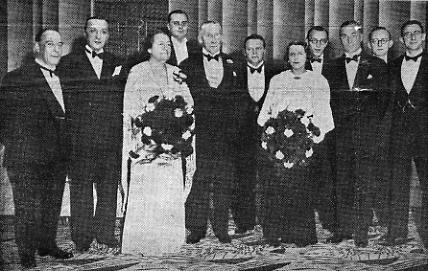 |
|
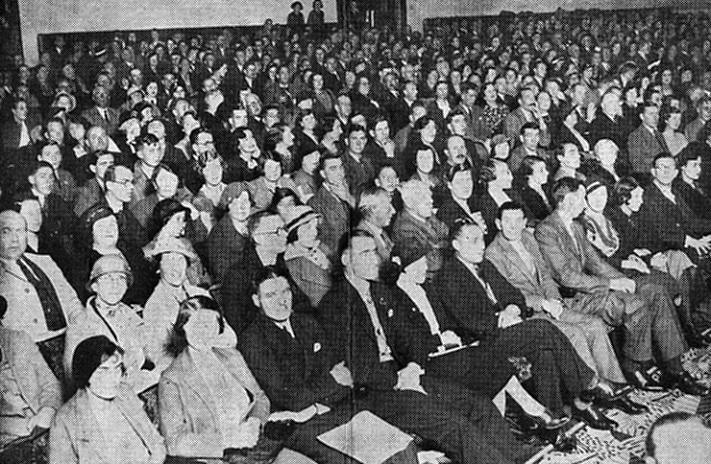 |
|
The official party at the
opening ceremony for the Majestic Cinema. 3rd and 5th
from the right are Sir Malcolm and Lady Campbell. 3rd and
5th from the left are The Reigate Mayoress and Mayor, Mrs
and Colonel F.J.Spranger. The gentleman far left is Mr
Bancroft.
|
|
Part of the audience on the
opening night.
|
| |
|
|
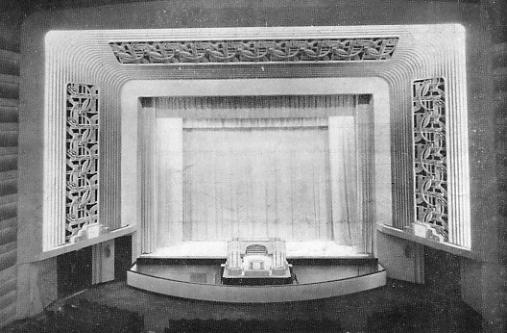 |
|
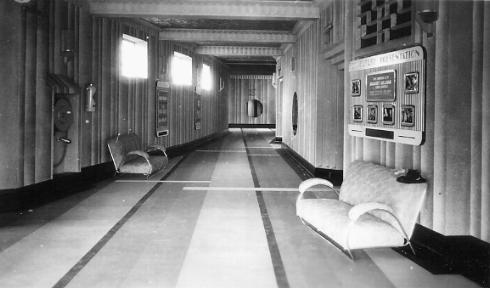 |
|
How the screen and Christie
organ looked on opening night
|
|
The corridor leading to the upper
balcony and the restaurant beyond
|
|
The Majestic seen looking east
along Bancroft Road
(Picture
Brian Burrows)
|
|
The Majestic seen looking west
along Bancroft Road, the Reigate Garage can be seen
across Bell Street.
(Picture Brian Burrows)
|
| |
|
|
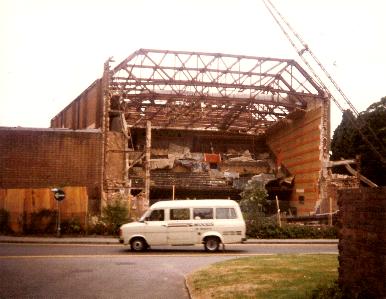 |
|
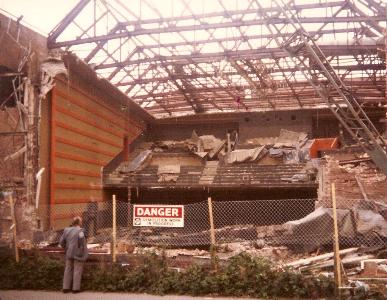
|
|
The demolition of the Majestic
cinema
(Pictures
Brian Burrows)
|
| |
|
|
|
|
Now we
resume our journey along Bell Street
|
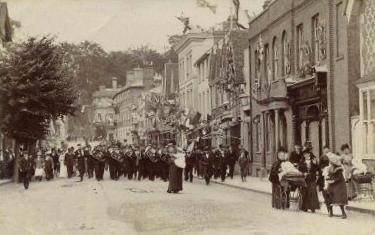 |
|
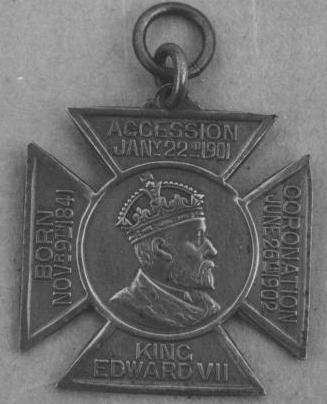 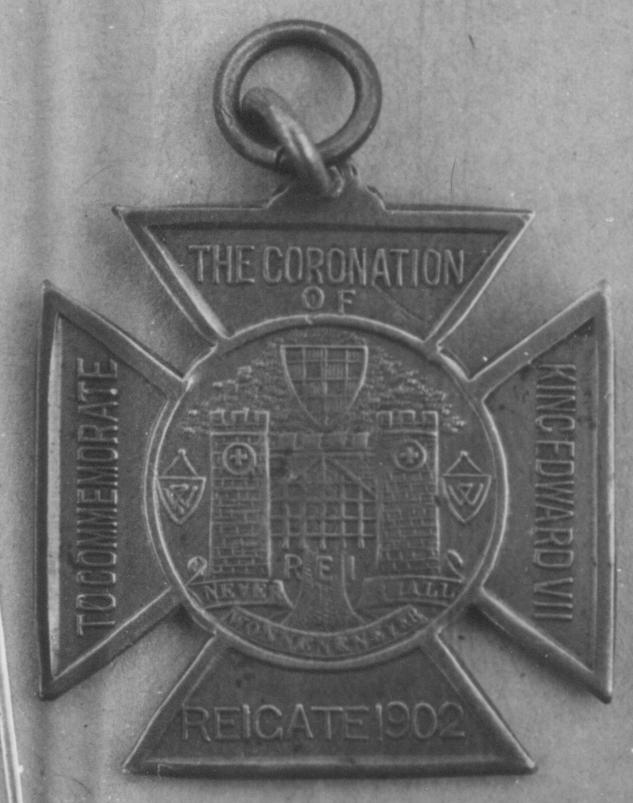 |
|
A marching band in Bell Street in 1903.
The buildings are decorated for the coronation on King
Edward VII on August 9th. Note that the procession is
passing the buildings demolished to make Bancroft Road.
(picture
courtesy of a Reigate resident)
|
|
The two sides of a medal struck
for and issued by the Borough of Reigate Corporation to
commemorate the coronation of King Edward VII. The delay
in the coronation was due to the King's illness
|
| |
|
|
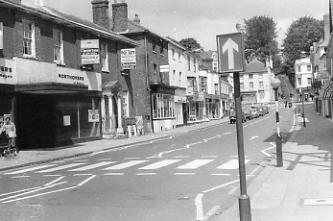 |
|
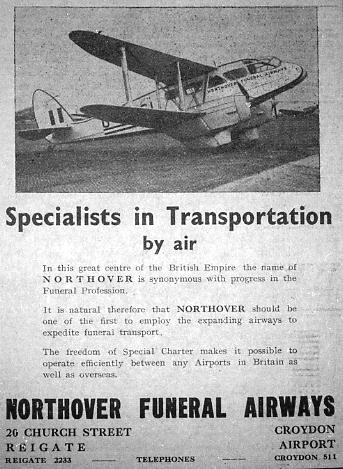 |
|
A view up Bell Street from the corner of
Bancroft Road towards the centre of the town in the 1970s
when Northovers premises, left of picture and next door
to the Post Office, had recently been vacated
|
|
Northovers were involved in
several lines of business, one of which features in this
1940s advertisement . . .
|
| |
|
|
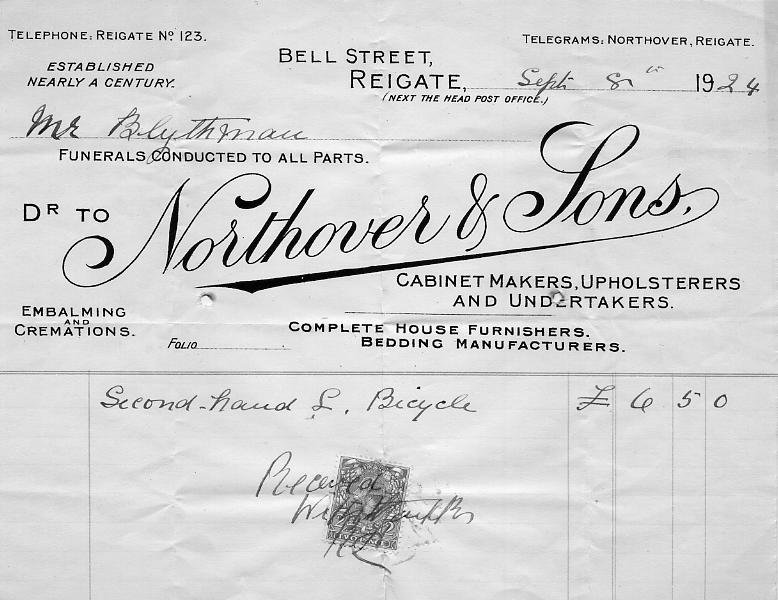 |
| . . . . and others that included
ladies bicycles in addition to the furnishing and
upholstery shown on this 1924 bill
|
| |
|
|
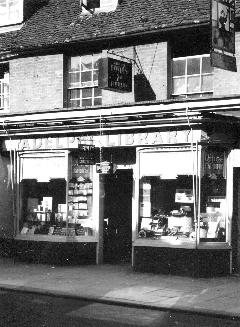 |
|
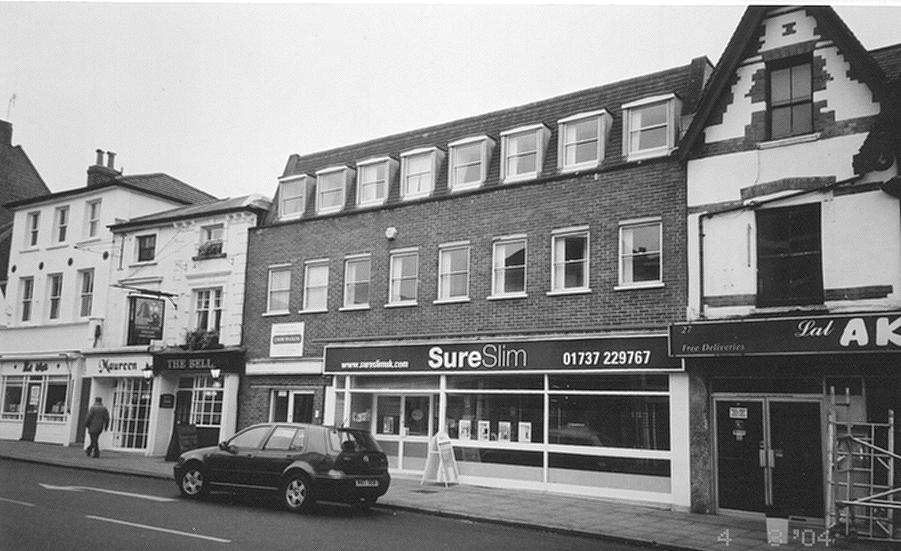 |
|
No 19 Bell Street was was once the
premises of George Lampard, Butcher, but by 1938 was home
to the Adelphi Library. The buildings where the Adelphi
library and other shops were has since been demolished
and rebuilt
(Adelphi
picture courtesy HNHC)
|
| |
|
|
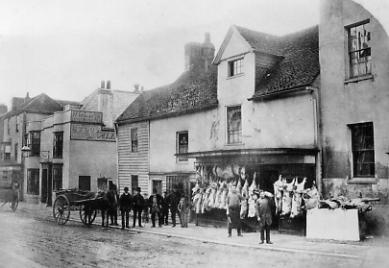 |
|
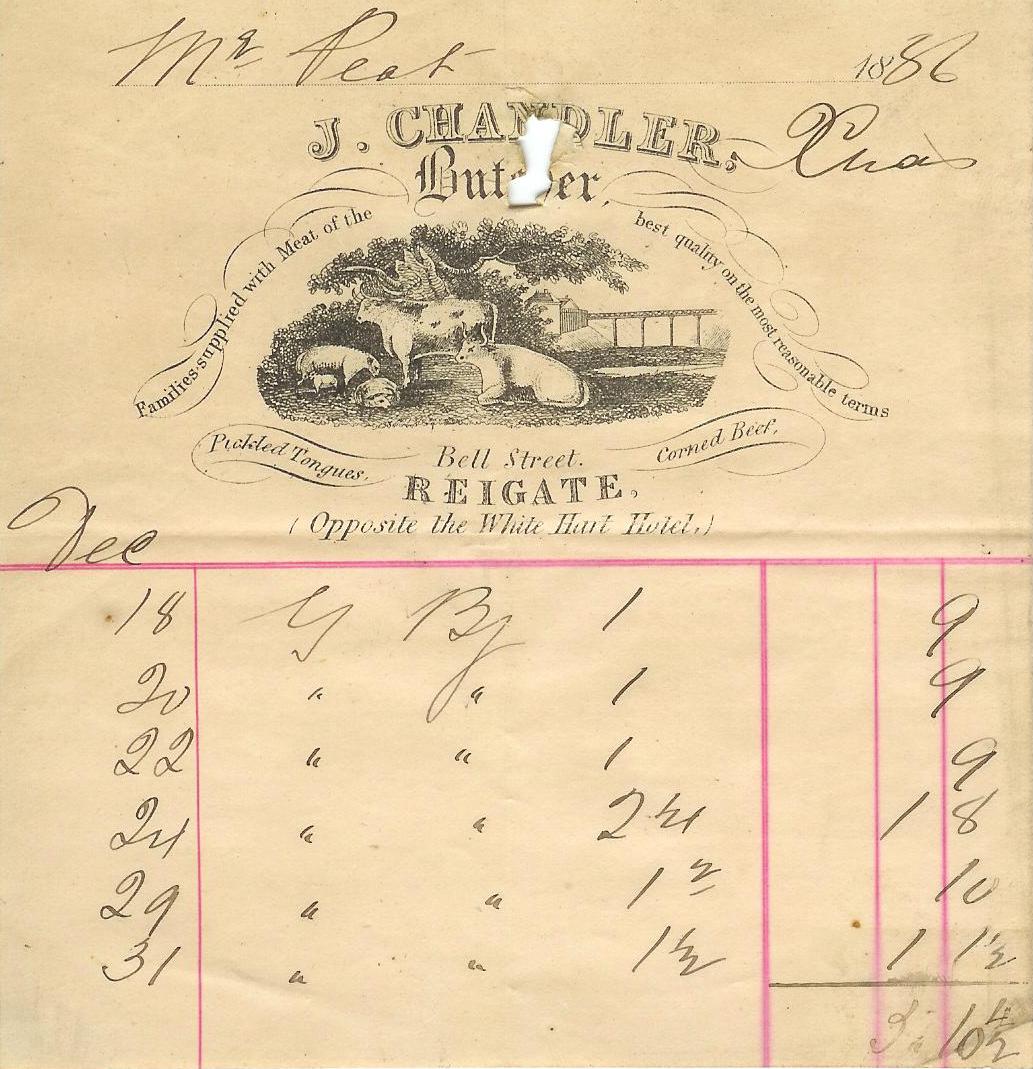 |
|
In this picture from the late
1800s the building behind the cart is the Grapes Hotel.
The picture was taken from the northern extemity of Bell
Street which terminates at the centre of the town. The
building on the right is on the corner of Bell Street and
the Market Place end of High Street. The butcher's shop
is that of J.Chandler. The 1898 directoy lists no
butchers at that site and the bill for three pounds and
tenpence ha'penny shown right is from the butcher to Mr
James Peat who lived in one of these buildings on the
same side ofBell Street. He ran an estate agency /
property maintenance business from offices in the High
Street. The bill advertises pickled tongue and corned
beef and states its position as opposite the White Hart
Hotel.
(Photo
courtesy John Eede - Invoice courtesy L.Robertson)
|
| |
|
|
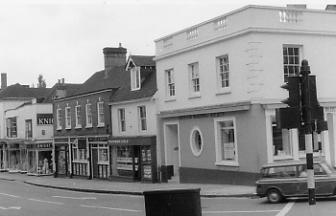 |
|
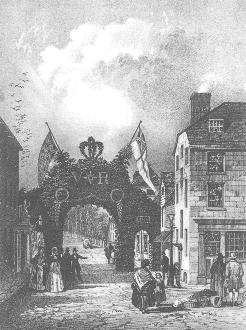 |
|
This is a 1970s picture of the
west side of the north end of Bell Street in which the
coner position of the building on the right can be better
appreciated. It will also be noticed that the buildings
centre of picture have been rebuilt and the one on the
right substantially altered. Far left of picture what was
the Grapes Hotel is now part of Knight's shop
|
|
This engraving shows Bell
Street decorated for the arrival of Queen Victoria when
she passed through on her way to Brighton in 1837. It
shows us what the building on the corner of Bell Street
and the Market Place in the centre of the town looked
like then. When it was altered c1900 some of the
architectral features were re-used elsewhere. The curved
window over the door, for example, still exists in a
house in Redhill. Further alterations follwed in later
years to reduce the building to two storeys
|
| |
|
|
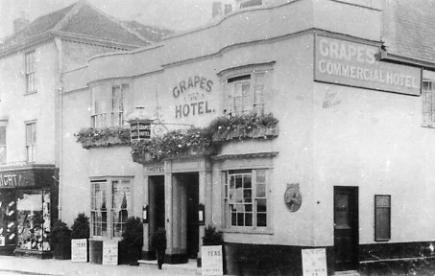 |
|
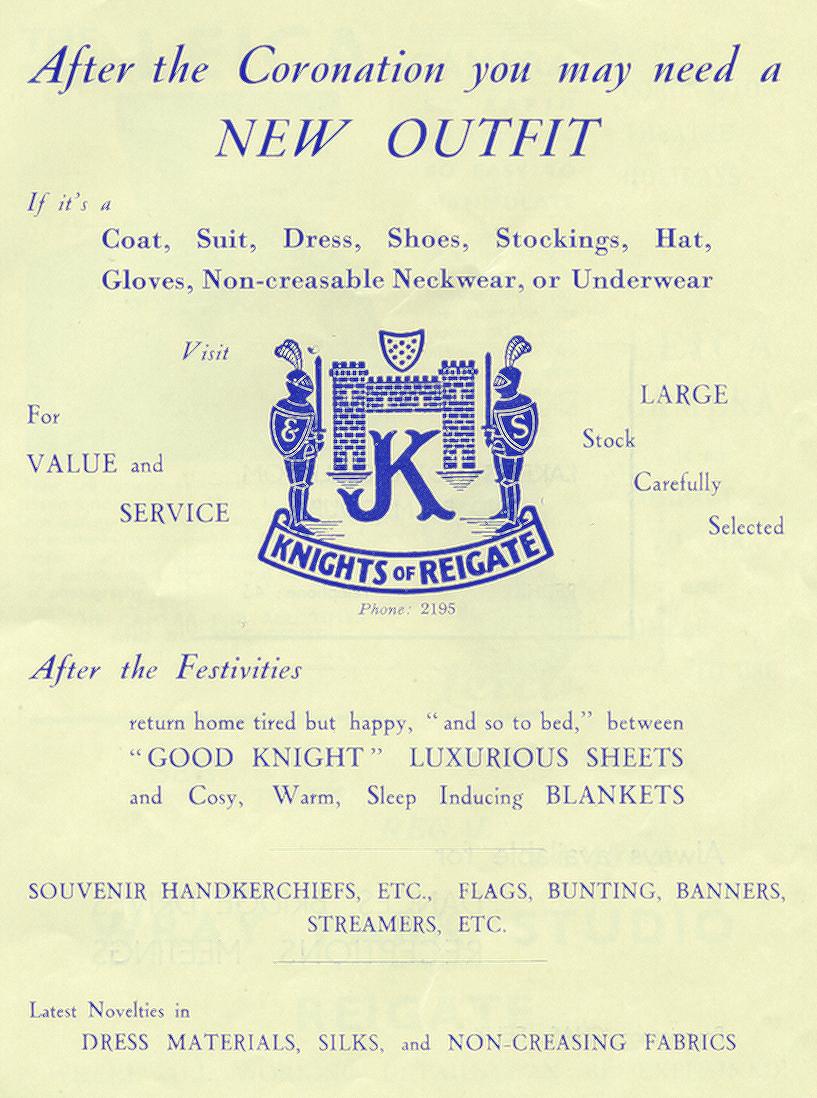 |
|
Here the Grapes Hotel can be
seen as it once was. At the time of this picture Knights
had only the premises next to the Inn
(Picture courtesy John Eede)
|
|
A 1937 Knights' advert
|
| |
|
|
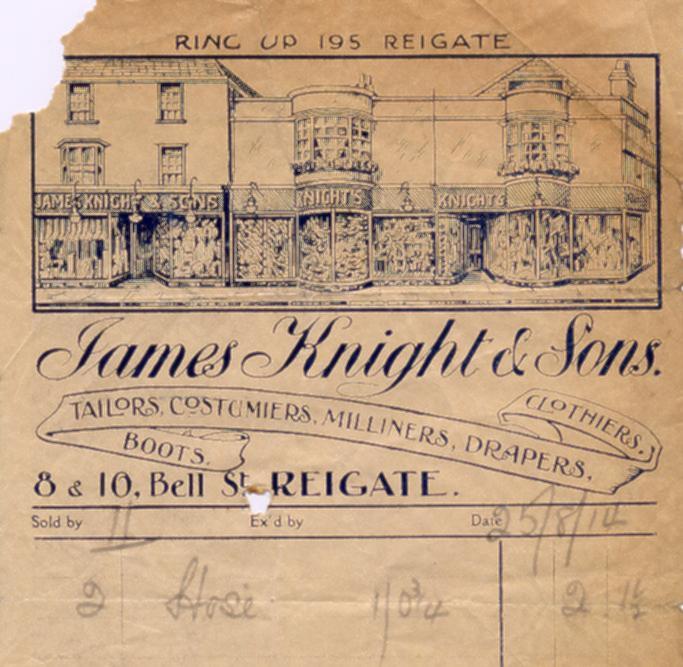 |
|
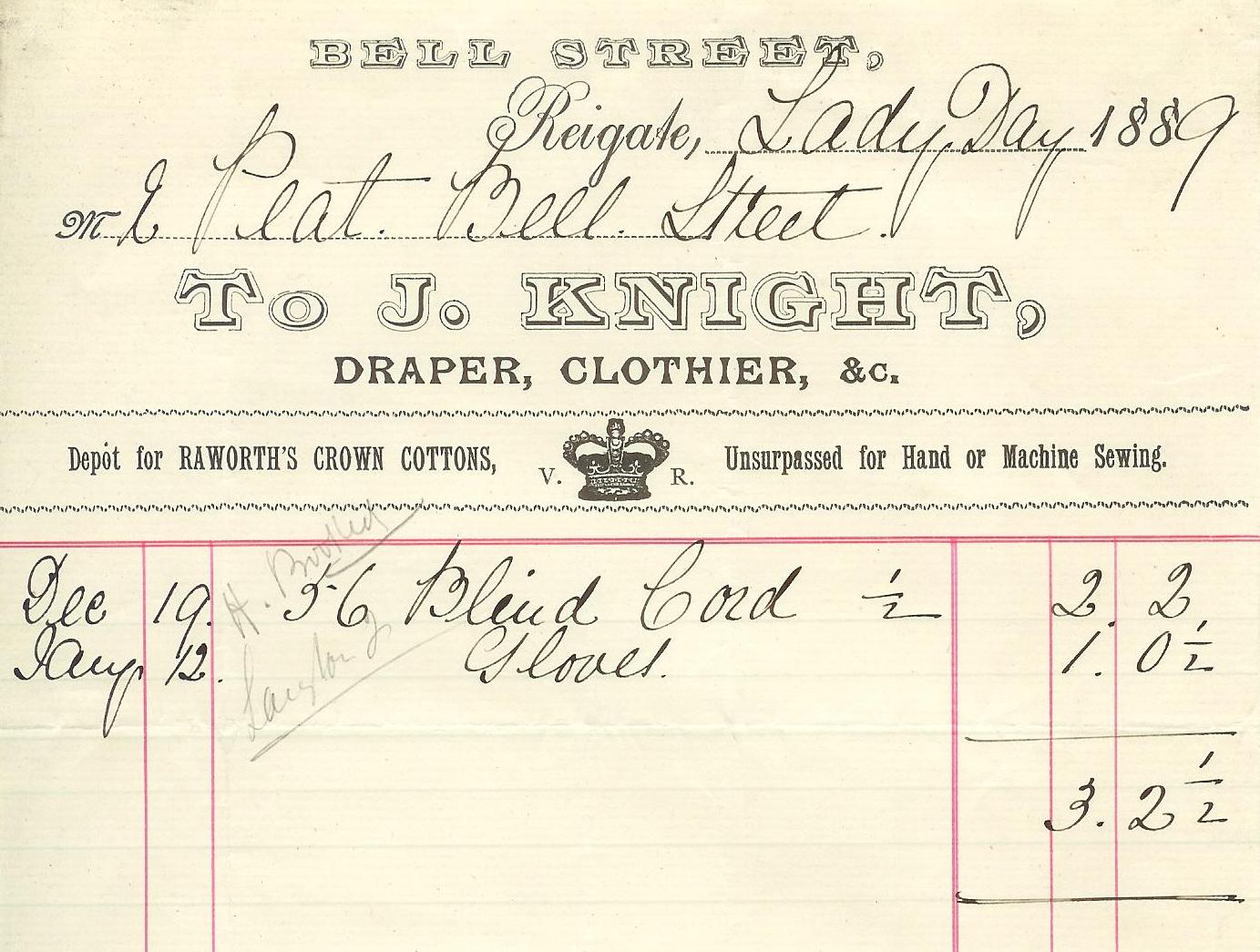 |
|
This bill from August 1914
shows the two buildings in use by Knights
|
|
An even earlier Knight's bill
for a length of blind cord and gloves came to three
shillings and tuppence ha'penny
(Invoice courtesy L.Robertson)
|
| |
|
|
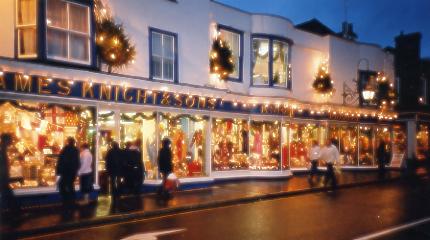 |
|
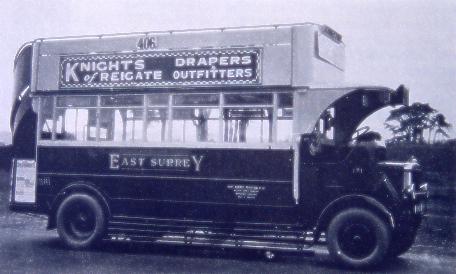 |
|
Left: - Knights' shop decorated and lit
up at Christmas 2003 Right: - An early East Surrey
Traction Company 406 route with a Knights' advertisement
|
| |
|
|
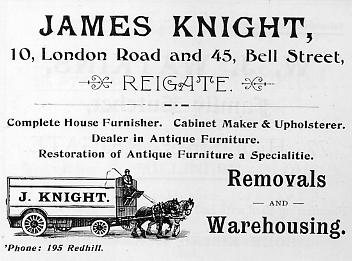 |
|
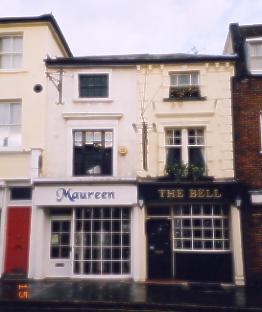 |
|
A
James Knight advert from 1905
|
|
The Bell public house is
opposite Knights' shop. The pubs of Reigate are to be
dealt with in more detail on a separate page that is
currently under development
|
|
Mellersh and Neale's Brewery - Not
far from the Bell Street premises of James Knight and
Sons, previously pictured, was the entrance into the
brewery of Mellersh and Neale. Thomas Neale founded the
brewery in 1801 when King George III was still on the
throne, and its original name was Thomas Neale and Sons.
It later became Neale and Mellersh, then Neale, Mellersh
and Neale, and finally Mellersh and Neale. A brewery
needs a good water supply and for the first 100 years
this came from wells at the base of Reigate Hill. The
quantity was good but the quality slightly less so. In
1901 a 242 feet deep artesian well was sunk on the
premises and excellent water found. An 8hp engine pumped
4,000 gallons per hour.
|
| |
|
|
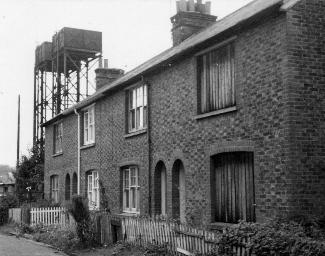 |
|
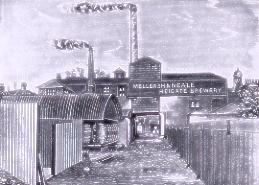 |
|
Brewery Cottages once stood in a small
backwater on the west side of Bell Street
(Picture left courtesy John
Eede).
They
were named after the brewery, the site of which not only
occupied ground behind the shops in Bell Street but also
had offices and an access way in the High Street - see
the High Street page (when produced at a later date) for
pictures of it there. The right-hand picture of the main
building above as viewed from Bell Street dates from
1891. Within a few years of this date that building would
be replaced
|
| |
|
|
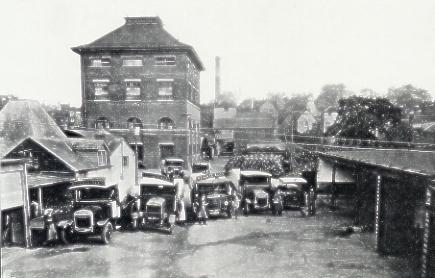 |
|
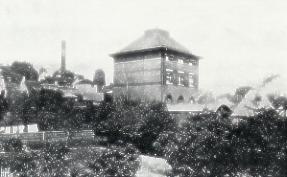 |
|
Its successor was built in 1903,
probably in front of the old building which would have
been demolished when the new one was fully operational.
The site had always been leased but in 1921, when by the
death of Lady Henry Somerset the whole town was up for
auction, the firm purchased the freehold. Expansion of
the brewery firm came with the purchasing of the famous
Swan Bewery of Leatherhead in 1922 and in 1930 that of
R&F Pagden of Epsom. Some of the internal operation
areas of the building pictures here are shown below.
|
| |
|
|
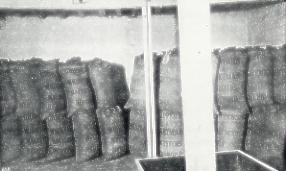
The malt store. Malt is
originally barley from which the starch is changed to
sugar
|
|
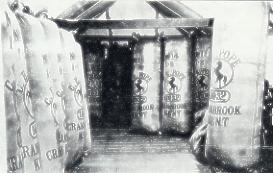
The hop store, receiver of hops
dried in the oast houses of Kent. The sacks they were
packed in were called pockets
|
| |
|
|
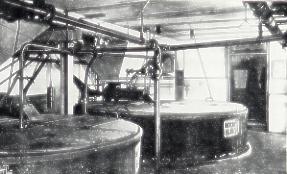
The mash tuns, where crushed
malt was mixed with water and a liquor known as sweet
wort drawn off
|
|
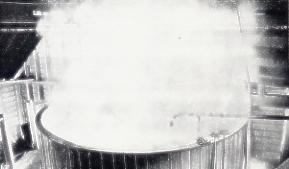
The 2,300 gallon Copper, where
the wort was boiled and the hops added
|
| |
|
|
|
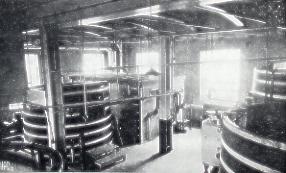
The
5,600 gallon fermenting tanks, where the wort, after
being cooled, had the yeast added.
|
|
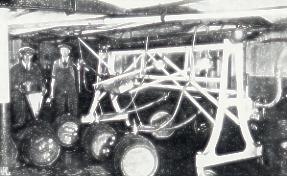
After
a week of fermentation the yeast crust was removed and
the beer descended to be piped into casks. A handful of
hops was also added to each cask
|
| |
|
|
|
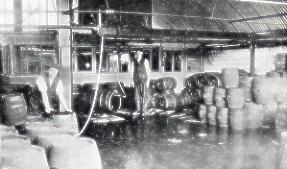
Cask
washing. Water at 212 degrees F was injected at 200lbs
pressure for 30 seconds to cleanse the insides
|
|
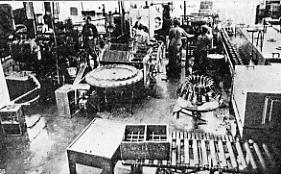
Bottled
beer was dealt with by the bottle washing and filling
machinery
|
| |
|
|
|
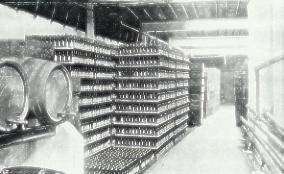
Part
of the bottled beer store. From 1900 beer was also stored
in the caves off of tunnel Road
|
|
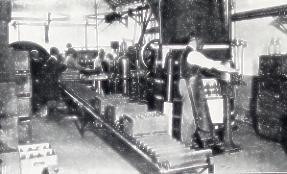
The
mineral water plant was originally the maltings and was
converted to produce aerated water when the new building
was put up in 1903
|
| |
|
|
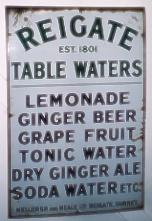 |
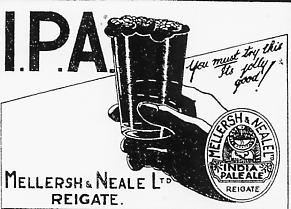 |
|
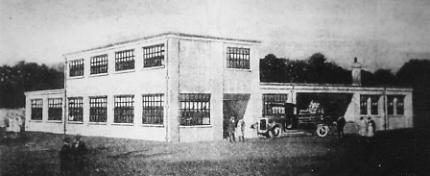 |
|
A pair of Mellersh and Neale
adverts
|
|
The operation areas shown immediately
above this picture was that of the mineral water plant in
1933. Originally housed with the rest of the complex this
facility was rebuilt as a separate plant in 1935. This is
an artist's impression of how the new plant would look.
Below is a photo of it from the same angle when
completed
|
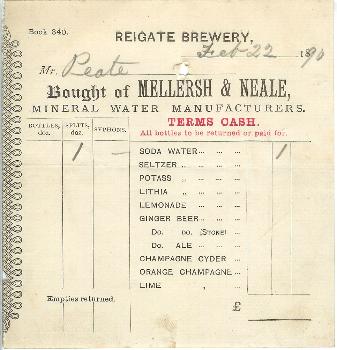 |
|
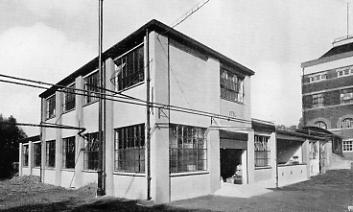 |
|
A Mellersh
& Neale invoice dating from 1890
(L.Robertson)
|
|
|
| |
|
|
A Mellersh and Neale of Reigate retail price list from 1936.
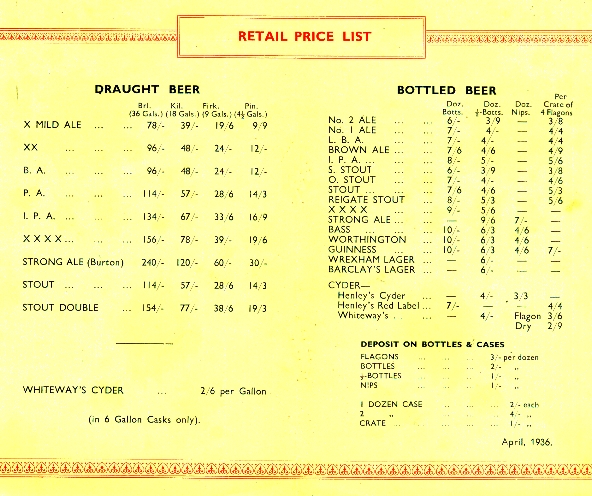
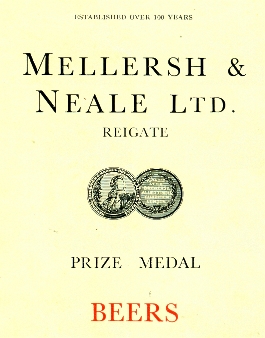
A comprehensive list
of beers from the Reigate Brewery at a variety of prices
in the mid-30s. A barrel of the x mild ale works out at
3¼d per pint to the publican, sold perhaps for 3-3½d in
the public bar and slightly more in the saloon bar. The
strong ale is three times this price.
Bottled beers range
from 6d to 10d a bottle to the publican or off licence.
(2½p - 4p in today's money)
|
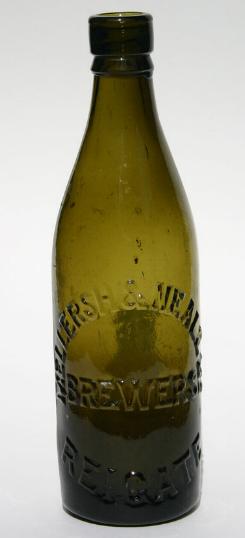 |
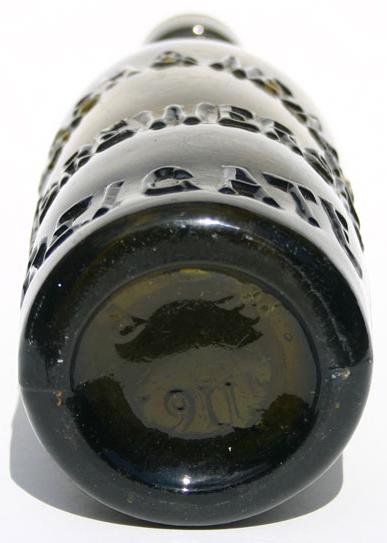 |
|
Two
pictures of a Mellersh and Neale beer bottle inscribed
'Mellersh and Neale Brewers Reigate', and on the bottom
the date of manufacture 1911. It seems that Mellersh
& Neale were the only brewery which actually used the
date on the bottom of their bottles - they also used it
on their screw-caps as well. The majority of other
breweries and mineral water firms either had plain bases
or batch-marks. (Pictures kindly supplied by Kate Ganley)
|
| |
|
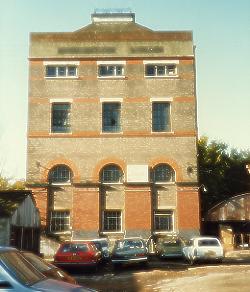
More
about Mellersh and Neale's Brewery
Thomas
Neale, came from an old Reigate family, the members of
which were mostly involved in the brewing industry. As a
boy he was apprenticed to his father and studied malting.
Another apprentice was William Lee who became his
lifelong friend and, later, partner. When Thomas
inherited the property in 1801 he concentrated on
brewing. He went into partnership with William Lee from
1806 to 1828 when Lee retired. At this point a brewery
that Lee had also been running in Church Street was sold
to Edward Larmer who converted it to a malting house,
later to become the Old Wheel Tea House. Other breweries
in Reigate had by then been acquired as had interests in
various pubs in the locality. Thomas Neale also carried
on business as a coal merchant and banker. By now the
firm was known as Thomas Neale and Sons. He sold the
brewery to his sons, Thomas and William, in 1843, and the
pubs in 1849. The bank failed in 1850, an event said to
have contributed to Thomas's death. The two sons invited
a family friemd, Frederick Mellersh, into the business,
which then became Mellersh and Neale. Son Thomas Neale
died in 1854 and had made arrangements for his son,
Sisson, to be made a partner in the business. When this
happened in 1865 the firm became Neale, Mellersh and
Neale. William Neale retired in 1883 when the firm was
restyed as Mellersh and Neale. Sisson's three sons joined
the business in 1888 and in the following year the firm
became Mellersh and Neale Ltd. Sisson Neale retired in
1919. The business was acquired by Meux in 1938.
(The subject of brewing in
Reigate, including that by Mellersh and Neale, is covered
in depth by Richard Symonds in his book 'A Brewing
Heritage'. )
Above - The brewery building of Mellersh and Neale just
before it was demolished in December 1989/January 1990.
The building was built to a design approved by Lady Henry
Somerset, leaseholder and Lord of the Manor but the roof
line was altered in 1935 after a large piece of masonery
fell just missing an employee
(Picture John Ede)
|
| |
|
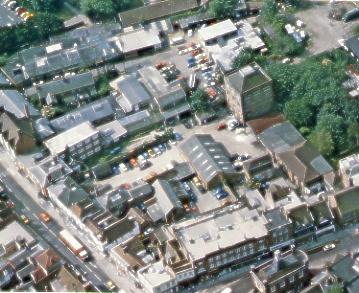
The brewery occupied a large site with access not just to Bell Street but also to the High
Street where its offices were.
This 1981 aerial view
of the brewery site shows Bell Street bottom left and the
Market Place and High street bottom right. The site is
now occupied by Safeways (now Morrison's) and its
carpark.
(picture courtesy HNHM)
|
| |
|
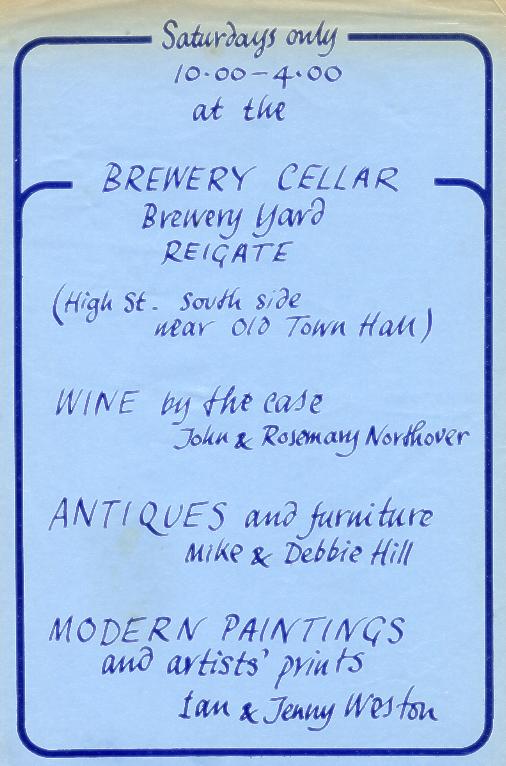
A flyer for sales at the brewery site
c1970s (reproduced courtesy of Gary Brown)
|
| |
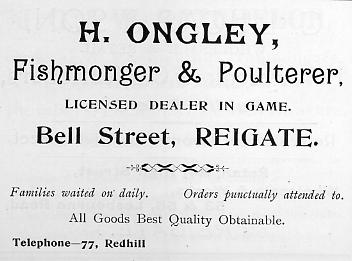 |
|
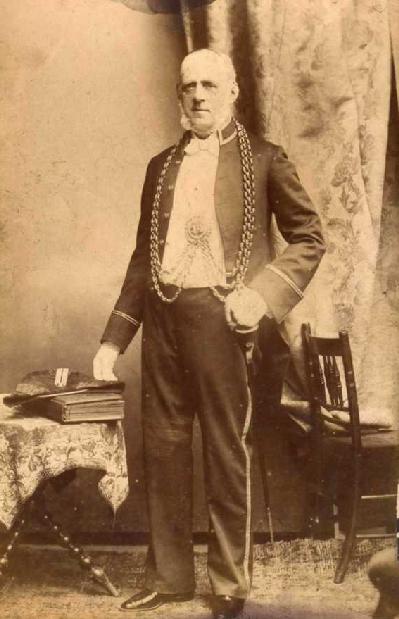 |
|
1905 advertisement
|
|
A vendor of poultry game and
fish by trade, Mr Ongley, whose shop is featured
in the advert left, was Mayor 1895-87. His Bell
street shop was the next property south from
Knights. Lived at 56 Deerings Road, Reigate.
(Picture all rights
reserved Mrs Abrahams)
|
| |
|
|
|
|
Marriages had businesses in Reigate and
Redhill. The access way for horse and wagon in their
Reigate premises on the east side of Bell Street existed
in 1891 but was later filled in and used as a shop. The
building as it is today is pictured right. It is a shame
that such outstandingly good features as its wonderful
gables should not be complimented by the shop fronts
below or the buildings either side
|
| |
|
|
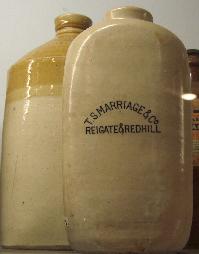 |
|
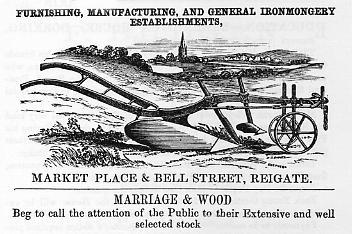 |
|
Earthenware bottles from
Marriages
(courtesy
HNHC)
|
|
An advertisement from 1860
|
| |
|
|
|
The charge of three shillings
and ninepence was invoiced to Mr Lanaway by Marriages for Making of new iron bar and
brass loop and fixing to side of Gladstone Bag'
The
invoice form dates from the 1880s but the date has not
been filled in and it may well have been used in the
1890s.
(Invoice courtesy L.Robertson)
|
|
A 1932 letter from Marriages
accepting Tom Burrows as a trainee sheet metal worker,
tin and copper smith for a one year period. Although the
header states T.S.Marriage the firm had by now been taken
over by JTP Aylward, builders merchants
(Letter courtesy Brian
Burrows)
|
|
A view back down Bell Street
c1915. It would seem that the postmen were aware of the
photographer's presence as they have turned out in force.
|
|
Bell Street looking south from
the Market Place in the centre of the town, with the
White Hart Hotel on the left. The crossing on the right
was probably one of those introduced in the times of
unmetaled roads to keep pedestrians feet dry when the
roads were muddy. They were made of wooden blocks and had
the disadvantage that horses slipped on them in the
wet.This view is around the same time as the one on the
left but is taken from further north so shows the White
Hart Hotel on the left
|
| |
|
|
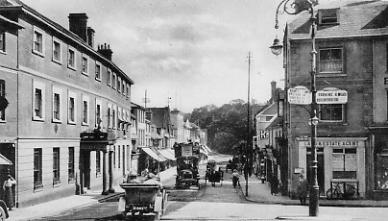 |
|
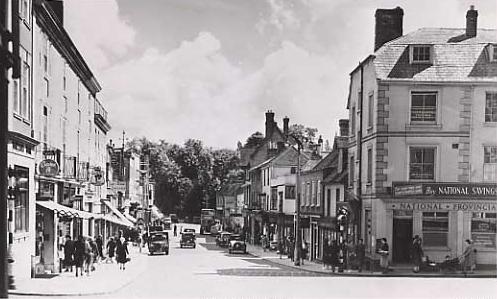 |
|
This time the view is from a few years
later, c1919, and again the White Hart Hotel can be seen
on the left. This picture also appears in Audrey Ward's
book 'Discovering Reigate Priory' where the caption draws
attention to the pre-1914 tourer in the foreground,
pointing out that it has a Leeds number plate
|
|
And yet another view back, this
one in the 1930s after the demolition of the White Hart
and its replacement by shops.
|
| |
|
|
|
This picture shows the northeast end of
Bell Street and its junction with Church Street. It was
taken around 1934-5 just after traffic lights had been
installed in both Redhill and Reigate
The ones at Reigate were
controlled partly by pads in the road and partly by time
signals
|
This picture taken at about the
same time as the one on the left
(picture
courtesy John Eede)
|
| |
The White Hart Hotel
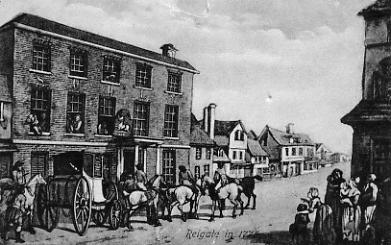
As one of the most notable old buildings in Reigate. Its
livery stables supplied fresh horses for coaches on the
London to Brighton run as well as extra pairs, to make
six horses in all, to assist coaches to the top of the
steep Reigate Hill, from where they returned to the hotel
to await the next London bound coach. Horses were also
supplied to pull the Reigate fire engine when required.
The White Hart Hotel was built c1775 on site of two
shops and a corn store and demolished in 1933, its
contents sold by at auction. In that year the Reigate
Amateur Film Society, then in its first stage of
formation, made a film called ‘Come to Reigate' in
which the White Hart Hotel featured as one of the older
parts of the town. George III, it is said, was known to
keep a bedroom reserved there, and Queen Victoria stopped
there briefly on her way to Brighton soon after her
accession. On another occasion she stopped there for
lunch with the Prince Consort and the baby Prince of Wales, later King Edward
VII.
The historical novelist William Harrison Ainsworth
lived there before he moved to Glovers Field, where he
died in 1882. He wrote 'Old Court' at the Hotel.
The building's history includes an incident in which an
army officer ran through one of the hotel's landlords
with a sword after an argument about a bad coin. The
officer was tried, condemned and hanged.
On Sept 18th
1838 a meeting of the inhabitants was held at the Hotel
to discuss the provision of gas for the town, following
which a company was later formed.
Above - a depiction of the White Hart in 1775.
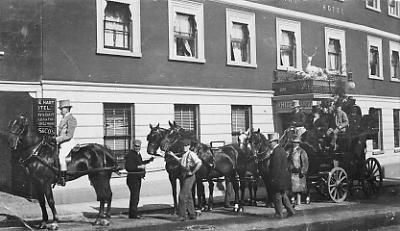
|
|
Above - a coach ready to leave with
additional pair added
|
|
|
| |
|
|
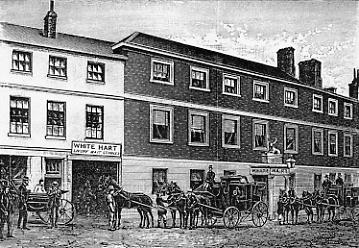 |
|
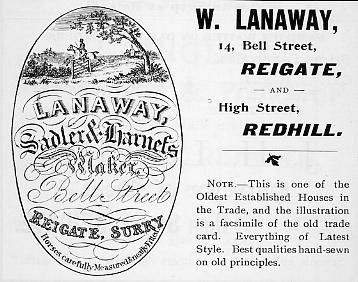 |
|
Below - the White Hart, an open carriage
and two coaches,1891
|
|
Opposite the White Hart in 1903 was the
saddler's business of William Lanaway
|
|
The Venture leaving Reigate for London.
Again, note the two additional horses as extra pulling
power for the ascent of Reigate Hill
|
|
Another coach either ready to leave
Reigate for London or newly arrived from Brighton
|
| |
|
|
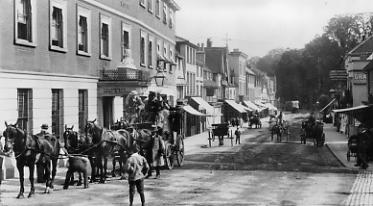 |
|
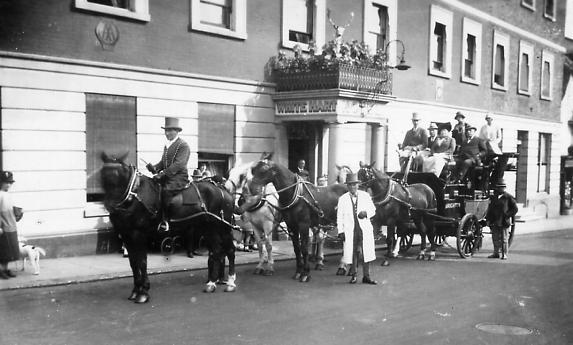 |
|
Coaches readying to depart
|
| |
|
|
|
Coaches at the White Hart certainly
provided good photo opportunities but other subjects were
not so readily taken. Fortunately for us the garden at
the rear of the White Hart Hotel above left was one that
was and we can see that it must have provided a tranquil
area so close to the busy centre of the town.The back of
the hotel can be seen and the buildings on the right were
presumably either additional guest rooms or livery
stables and stable lads' and coachmens' accomodation.
(Garden picture courtesy John Eede)
The room pictured above right doubled as the reading lounge and ballroom
|
| |
|
|
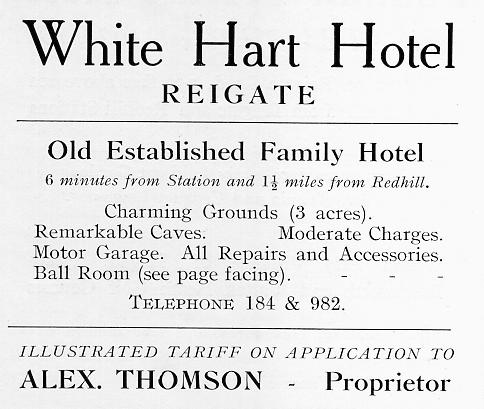 |
|
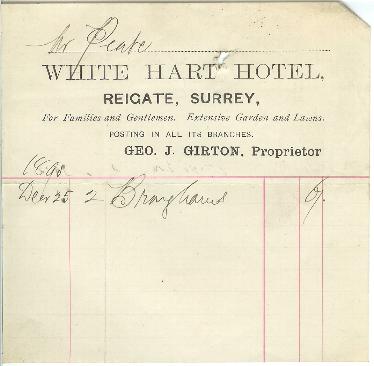 |
|
Above left is an advert for the
White Hart Hotel from 1932. By this time the livery
stables had given way to motoring facilities. The
reference to remakable caves is presumably a general one
to several caves in and under the town which will receive
mention on other pages. As far as this author is aware
there was no access to the caves directly from the hotel.
It would seem that the charming grounds referred to could
only be the hotel garden but they did not extend to three
acres, so perhaps the Castle Grounds not far from the
hotel's front door were included. This must have been one
of the last advertisements for the hotel as it was
demolished the following year. Above right is an 1890s
invoice from the Hotel
(invoice courtesy L.Robertson)
|
| |
|
|
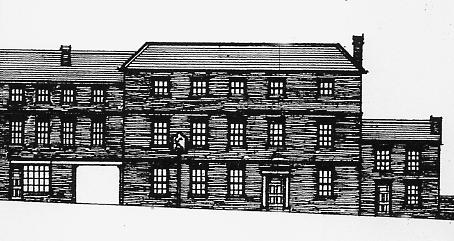 |
|
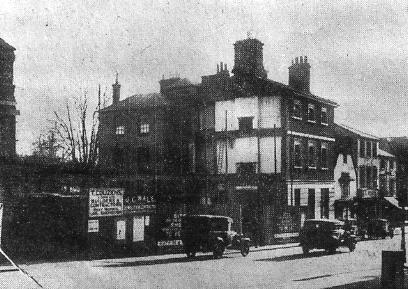 |
|
This
drawing (above left) by Morris Hooper was made at the
time of the demolition of the White Hart from
measurements he took shortly before its demolition and
was intended to show its dimensions in 1785. In three
parts, Mr Hooper speculated that the left part of the
building dated from 1700 and that the centre part was the
old White Hart proper, having been built around 1775 on
the site of three old shops. The southern portion had
been already been demolished, perhaps the 1830s. Above
right - The White Hart in process of demolition in 1933
|
| |
|
|
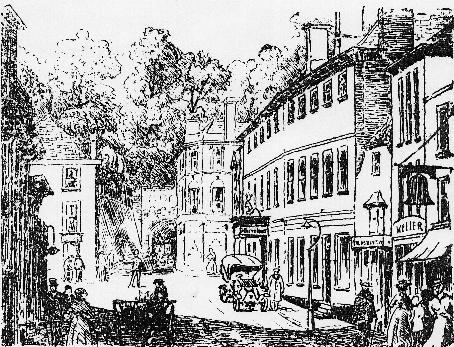 |
|
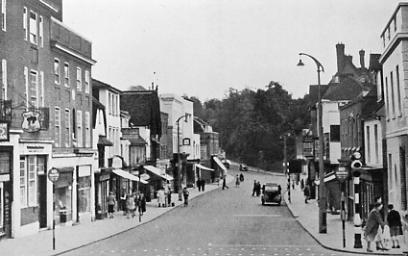 |
|
Bell Street and the town centre,
an early 1930s sketch by William Tatton Winter that looks
back to an earlier time. On the right is the White Hart
Hotel. Beside it, and dwarfed by it, is a building in
which are the remains of St Lawrence's Chapel.
|
|
The building with the remains
of St Lawrence's Chapel is the one with the distinctive
roof shape and awning above the 1st floor window on the
left hand side of the street in this 1930s/40s picture
|
| |
|
|
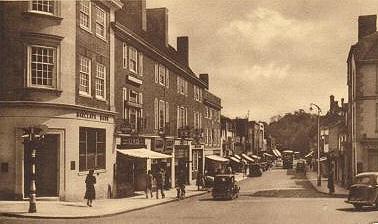 |
|
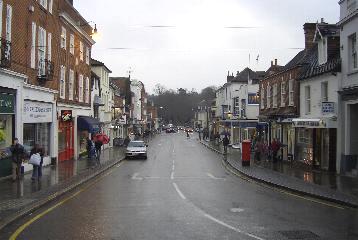 |
|
A view back down Bell Street in
the 1940s
|
|
A view back down Bell Street
late on a wet afternoon in February 2005
|
| |
|
|
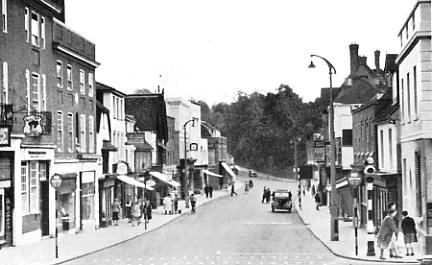 |
|
And a view from the very early
1950s
|
| |
|
|
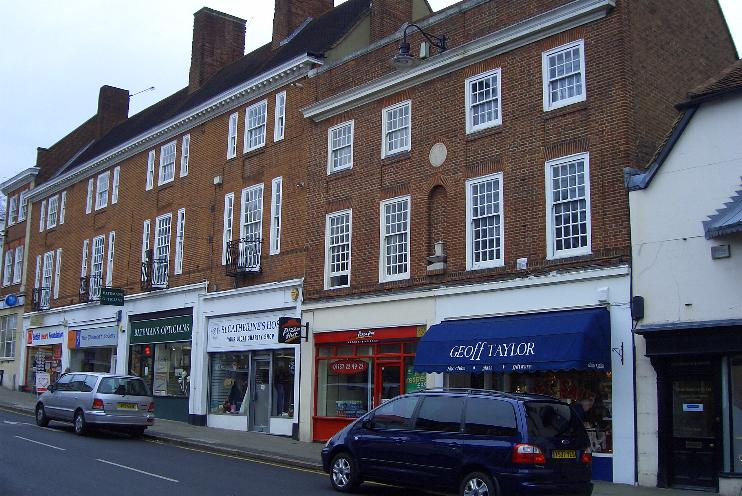 |
|
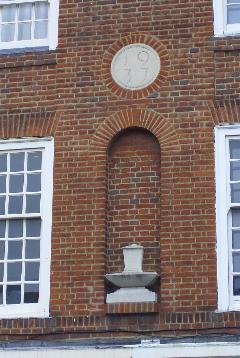 |
|
The buildings that replaced the White
Hart Hotel pictured in February 2005
|
|
Detail from the right hand part of the
building pictured left shows a 1937 date plaque
|
| |
|
|
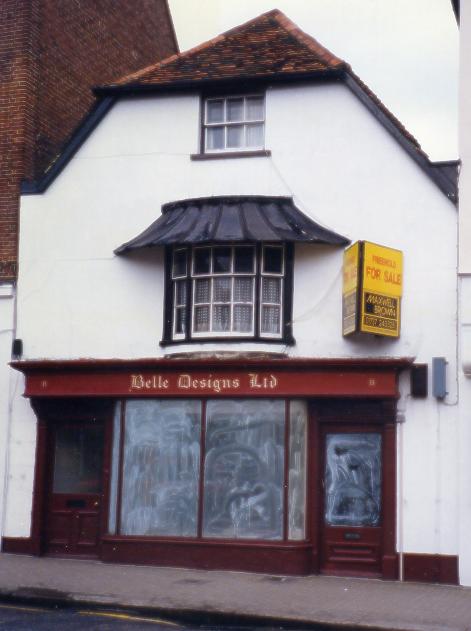 |
|
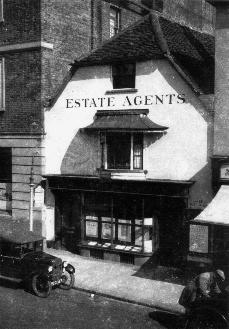 |
|
The buiding just visible in the
picture immediately above was once a 14th century chapel
known as the chapel of St Lawrence. No doubt it doesn't
look much as it did 600 years ago but some of the
medieval beams are visible inside and are shown below,
|
|
The same building pictures in
1936 when it was Holdsworth and Knight, the estate
agency
|
| |
|
|
|
A car in the 1896 run comes
down Church Street towards Reigate town centre before
turning into Bell Street, barely having room between thee
crowds of onlookers. This car had taken a route via the
A23 through Redhill, whereas others came down the A217 to
approach Reigate town centre via Tunnel Road
|
|
A car on the 1896 run turning
from Church Street into Bell Street
|
| |
|
|
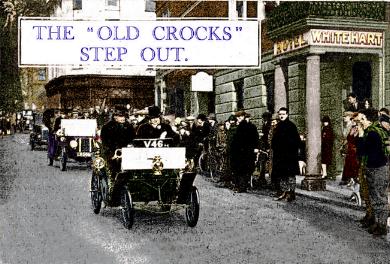 |
|
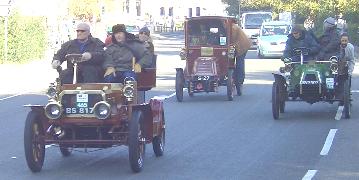 |
|
The Emancipation Run of 1896 vwas repeated for a few subsequent years by the Motor Car Club but to different destinations than Brighton and eventually ceased. The
Veteran Car run as we know it today was reveived on the 13th November 1927 by the Daily Sketch and Sunday Graphic newspapers, which promoted it as 'the Old Crock’s
Race
The Royal Automobile Club took over organisation of the event in 1930 and do so to this day. In 1952 the date was fixed for the 1st Sunday in November. This was the year that the film
Genevieve' was
made.
In the picture above vehicles taking part in the 1927 run pass the White Hart Hotel having come down Reigate Hill and through the tunnel
|
|
The original 1896 route was via
Reigate or via Redhill and then on to Reigate. From 1927
the route was via Reigate for many years.until it was
changed to Redhill (late 1950s/early 1960s?). Here
vehicles are shown passing through Redhill in 2006
|
| |
|
|
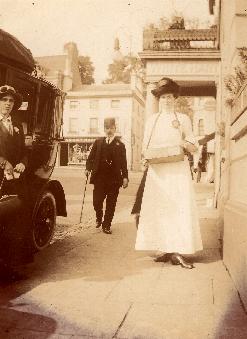 |
|
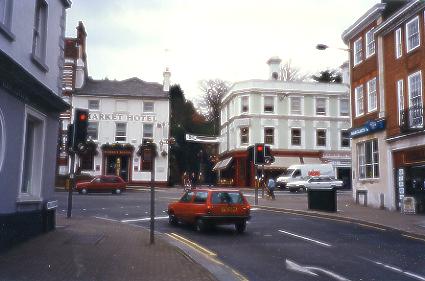 |
|
Doris Peat collecting money for
the Hospital Saturday Fund outside the White Hart in
1913. Doris was a teacher at the infants' school in
Somerset Road Meadvale.
(Picture all rights reserved Mrs
Abrahams)
|
|
Bell Street
ends at the centre of the town at the Market Place, which
was the old name for the junction of Bell Street with
Church Street on the right, Tunnel Road straight ahead
and the High Street to the left. These highways and
others will eventually be pictured and described on their
own pages
|
| |
|
|
|
